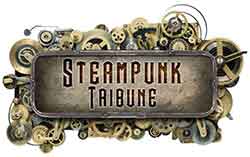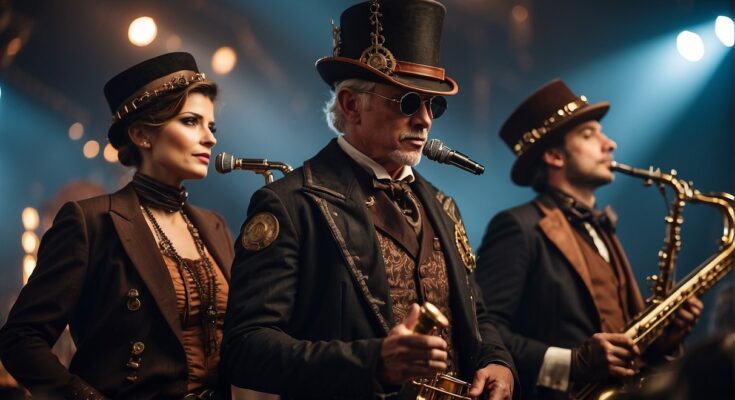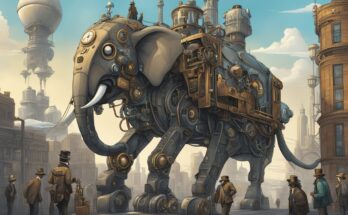Steampunk instrumental music transports listeners to an alternate reality where the Victorian era collides with futuristic imagination, all expressed through sound. Characterized by its use of both vintage and modern instruments, this genre creates a rich tapestry of auditory experiences. Steampunk music often features the use of classical instruments such as the violin and piano merged with contemporary electronic sounds, generating a unique blend that evokes the past and the future simultaneously.

This genre is not just music, but a part of a larger steampunk cultural movement that embraces a speculative vision of history. The music underscores themes of invention, exploration, and the melding of technology with human artistry. Through it, one can almost hear the turning of gears and the steam powered inventions of a world that never was—a signature aspect that differentiates steampunk instrumental music from other musical forms.
The influence of steampunk can be heard in the works of various composers and musicians who have embraced this aesthetic. They create intricate soundscapes that embody the essence of steampunk, weaving elements of nostalgia with modern experimental techniques. Live performances often enhance the experience with period costumes and thematic stage design, adding a visual element to the aural journey. Steampunk instrumental music is not just for enthusiasts of the genre but offers a unique experience for any adventurous listener seeking to explore new musical frontiers.
Origins of Steampunk Music

Steampunk music combines the aesthetics of 19th-century industrial steam-powered machinery with modern musical elements. It’s a genre deeply rooted in eclectic influences and unique soundscapes.
Defining Steampunk
Steampunk, as a cultural phenomenon, references a Victorian and Edwardian-inspired alternate history, often characterized by steam-powered technology and a strong DIY ethos. The music within this genre is an audible extension of this concept, incorporating instrumental sounds that evoke the same retro-futuristic atmosphere. Listeners can expect a blend of orchestral instruments with non-traditional sounds, like mechanical noises and synthesized beats.
Historical Influences
Steampunk music has historical roots stemming from the late 1980s to early 1990s when the literary genre of steampunk started gaining traction, influencing various aspects of pop culture. Key components in this musical style include:
- Victorian-era Romanticism: Emphasized through lush orchestrations and dramatic storytelling.
- Industrial Revolution: Mirrored in the use of mechanical and metallic sounds to mimic the noise of factories and steam engines.
- Modern Electronic: The juxtaposition of old and new is central to steampunk music, with contemporary electronic music techniques weaving through the traditional melodies.
This fusion creates an intricate soundscape that is both nostalgic and innovative, mirroring the steampunk ethos in auditory form.
Instruments and Sound

Steampunk instrumental music distinguishes itself through the use of eclectic instruments and a focus on compositional structure. This genre merges the sounds of traditional instrumentation with unexpected, mechanical, and often anachronistic sonic elements.
Unique Instruments in Steampunk
List of Steampunk Instruments:
- Hurdy-gurdy: A stringed instrument that produces sound by a hand-crank-turned, rosined wheel rubbing against the strings.
- Theremin: An electronic musical instrument controlled without physical contact, emanating an eerie sound.
- Musical Saw: A hand saw played with a bow to create haunting melodies.
- Steam Organ: An organ powered by steam, invoking Victorian-era mechanics.
In steampunk music, instruments often appear modified or are crafted to reflect a Victorian aesthetic, blending seamlessly with more conventional instruments such as violins and pianos to create a distinct auditory landscape.
The Role of Instrumentals
Instrumentals form the backbone of steampunk music. They are:
- Narrative Tools: Instrumental compositions tell stories without words, using tempo changes and dynamic shifts to convey action and emotion.
- Mood Setters: They shape the atmosphere, evoking images of steam-powered machinery and bygone eras tinged with a sense of modernity.
The instrumental nature of steampunk music allows for a broad sonic exploration, inviting listeners to imagine their own adventures within a retro-futuristic world. The absence of lyrics in such music places a greater emphasis on the instruments and the textures they create.
Popular Steampunk Instrumental Artists

The genre of steampunk music often draws from the themes of retro-futurism and speculative fiction, where artists like Autumn Tears and Synthetic Dream Foundation have established a dedicated following with their unique instrumental sounds.
Autumn Tears
Autumn Tears stands out in the indie music scene with their neoclassical and darkwave influences. Since their inception in 1995, they have crafted an evocative sound that embodies the essence of steampunk aesthetics without the reliance on lyrics, creating a rich tapestry of instrumentation.
- Origin: United States
- Active Years: 1995–present
- Key Albums:
- Love Poems for Dying Children, Act I (1996)
- The Glow of Desperation (2021)
Synthetic Dream Foundation
Synthetic Dream Foundation has carved a niche within the steampunk community with an eclectic blend of dark ambient and industrial tones. Their music is a sonic exploration of a fantastical past that never was, seamlessly integrating classical music with electronic elements.
- Origin: United States
- Active Years: Early 2000s–present
- Key Albums:
- Tendrils of Pretty (2006)
- Mechanical Serpent (2010)
Steampunk Music in Digital Media

The proliferation of steampunk music in digital media has provided a unique niche for enthusiasts seeking a blend of retro-futuristic sounds. Platforms like YouTube have become repositories for steampunk music, while steampunk music mixes on various sites cater to a growing fanbase.
YouTube and Steampunk Music
YouTube has emerged as a vital platform for steampunk artists and fans. Musicians often release their work on their own channels, offering a diverse array of steampunk instrumental music. These channels range from small, independent creators to more established music labels, all featuring steampunk-themed visuals paired with their releases.
Popular steampunk music videos on YouTube typically include:
- Live performances
- Animated music videos
- Lyric videos
Additionally, YouTube’s algorithm helps new listeners discover steampunk music by suggesting videos based on their viewing habits, which contributes to the genre’s growth.
Steampunk Music Mixes
Online, listeners can find various steampunk music mixes that provide hours of uninterrupted listening. These mixes compile tracks from multiple artists, creating a cohesive auditory journey through the steampunk landscape.
Websites hosting steampunk music mixes include:
- SteampunkRadio: A dedicated station streaming a selection of steampunk music.
- Music streaming services (e.g., Spotify, SoundCloud): Curated playlists under “steampunk” tags.
Fans of the genre revel in the convenience of these mixes, often using them as a background soundtrack for activities or to immerse themselves in the steampunk aesthetic. These mixes serve as an accessible entry point for newcomers to the genre.
Conceptual Themes in Steampunk Music
Steampunk instrumental music often encapsulates themes of a bygone era reimagined with futuristic elements. Each piece frequently serves as a narrative, inviting listeners on an evocative journey.
Odes to Time and Change
Odes in steampunk music typically pay homage to the relentless flow of time and the transformation it brings. For instance, the piece “Ode to My Forthcoming Winter” encapsulates the fusion of ending and beginning, mirroring the cyclic nature of seasons—a powerful metaphor for change within the steampunk genre. This ode uses instrumentation suggesting the ticking of clocks and steam-powered machinery, representing time’s passage.
Steampunk Narrative Elements
Steampunk music pulls listeners into a narrative filled with retro-futuristic elements. For example, “Moon Ate the Dark” uses somber piano melodies intertwined with mechanical sounds to create a storytelling soundscape. Here, the moon represents an entity with whimsical power within a steampunk world, while the accompanying dark, ambient noise becomes the backdrop against which the narrative unfolds.
Fostering a Steampunk Music Community
Creating a vibrant community around steampunk instrumental music involves connecting fans, musicians, and creators who share a passion for the genre’s unique blend of Victorian-era aesthetics and inventive elements. The online platform YouTube has become a central hub where enthusiasts can explore and revel in steampunk music. Channels dedicated to the genre showcase a variety of artists, providing a space where listeners can discover new music and interact through comments.
To bolster the steampunk music community, consider organizing and participating in the following activities:
- Collaborative Playlists: Curate shared playlists on streaming services to feature a mix of well-known and emerging steampunk artists, encouraging exploration and support within the community.
- Online Forums and Social Media Groups: Establish forums and social media groups that focus on steampunk instrumental music. These platforms allow members to share content, discuss favorite pieces, and coordinate online events or meet-ups.
- Virtual Events and Live Streams: Host live streams or virtual concerts featuring steampunk musicians. This helps fans connect in real time and supports artists by giving them exposure and a platform to perform.
- Fan Creations and Mashups: Encourage fans to create their own steampunk-themed music videos or mashups and share them on YouTube, further diversifying the range of content available to the community.
- Educational Content: Create and share informative content about the history and characteristics of steampunk music, deepening the community’s understanding and appreciation for the genre.
By engaging with these initiatives, the steampunk music community can foster a welcoming environment for both existing fans and newcomers, encouraging the growth and sustainability of this inventive musical landscape.




